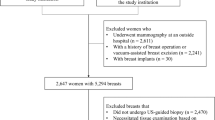Abstract
The division of breast cancer cells results in regions of electrical depolarisation within the breast. These regions extend to the skin surface from where diagnostic information can be obtained through measurements of the skin surface electropotentials using sensors. This technique is used by the Biofield Diagnostic System (BDS) to detect the presence of malignancy. This paper evaluates the efficiency of BDS in breast cancer detection and also evaluates the use of classifiers for improving the accuracy of BDS. 182 women scheduled for either mammography or ultrasound or both tests participated in the BDS clinical study conducted at Tan Tock Seng hospital, Singapore. Using the BDS index obtained from the BDS examination and the level of suspicion score obtained from mammography/ultrasound results, the final BDS result was deciphered. BDS demonstrated high values for sensitivity (96.23%), specificity (93.80%), and accuracy (94.51%). Also, we have studied the performance of five supervised learning based classifiers (back propagation network, probabilistic neural network, linear discriminant analysis, support vector machines, and a fuzzy classifier), by feeding selected features from the collected dataset. The clinical study results show that BDS can help physicians to differentiate benign and malignant breast lesions, and thereby, aid in making better biopsy recommendations.


Similar content being viewed by others
References
SEER Cancer Statistics Review 1975–2006, National Cancer Institute. Information available at http://seer.cancer.gov/csr/1975_2006/results_single/sect_01_table.01.pdf (last accessed Jan 2010).
Ng, E. Y.-K., Vinitha Sree, S., Ng, K. H., and Kaw, G., The use of tissue electrical characteristics for breast cancer detection: a perspective review. Tech. Cancer Res. Treat. 7(4):295–308, 2008.
Biofield Diagnostic System. Information available at http://www.mackaylifesciences.com/products.html (last accessed Jan 2010).
Vinitha Sree, S., Ng, E. Y.-K., Kaw, G., Rajendra Acharya, U., and Chong, B. K., The use of skin surface electropotentials for breast cancer detection: preliminary clinical trial results obtained using the Biofield Diagnostic System. J. Med. Syst., 2009. doi:10.1007/s10916-009-9343-0.
Davies, R. J., Underlying mechanism involved in surface electrical potential measurements for the diagnosis of breast cancer: an electrophysiological approach to breast cancer. In: Dixon, J. M. (Ed.), Electropotentials in The Clinical Assessment of Breast Neoplasia. Springer, New York, pp. 4–17, 1996.
Goller, D. A., Weidema, W. F., and Davies, R. J., Transmural electrical potential difference as an early marker in colon cancer. Arch. Surg. 121(3):345–350, 1986.
Marino, A. A., Iliev, I. G., Schwalke, M. A., Gonzalez, E., Marler, K. C., and Flanagan, C. A., Association between cell membrane potential and breast cancer. Tumour. Biol. 15(2):82–89, 1994.
Weiss, B. A., Ganpola, G. A. P., Freeman, H. P., Hsu, Y.-S., and Faupel, M. L., Surface electrical potentials as a new modality in the diagnosis of breast lesions: a preliminary report. Breast Dis. 7(2):91–98, 1994.
Faupel, M. L., and Hsu, Y.-S., Dedicated systems for surface electropotential evaluation in the detection and diagnosis of neoplasia. In: Dixon, J. M. (Ed.), Electropotentials in the Clinical Assessment of Breast Neoplasia. Springer, Berlin, pp. 37–44, 1995.
Sacchini, V., Report of the European School of Oncology Task Force on Electropotentials in the clinical assessment of neoplasia. Breast 5(4):282–286, 1996.
Faupel, M. L., Vanel, D., Barth, V., Davies, R., Fentiman, I. S., Holland, R., Lamarque, J. L., Sacchini, V., and Schreer, I., Electropotential evaluation as a new technique for diagnosing breast lesions. Eur. J. Radiol. 24(1):33–38, 1997.
Faupel, M., Barrett, B., Stephens, J., and Nathanson, S., inventors; Biofield Corp., assignee. D.C biopotential sensing electrode and electroconductive medium for use therein. United States patent US 5823957. 1998 Oct 20.
Cuzick, J., Holland, R., Barth, V., Davies, R., Faupel, M., Fentiman, I., et al., Electropotential measurements as a new diagnostic modality for breast cancer. Lancet. 352(9125):359–363, 1998.
Cuzick, J., Davies, R., Stephens, J., Borgwardt, V., Housworth, C., Lei, X., Gadsby, P., and Iskac, A., inventors; Biofield Corp., assignee. Method and apparatus for sensing and processing biopotentials. United States patent US 6351666. 2002 Feb 26.
Gallager, H. S., and Martin, J. E., Early phases in the development of breast cancer. Cancer 24(6):1170–1178, 1969.
Fukuda, M., Shimizu, K., Okamoto, N., Arimura, T., Ohta, T., Yamaguchi, S., et al., Prospective evaluation of skin surface electropotentials in Japanese patients with suspicious breast lesions. Jpn. J. Cancer Res. 87(10):1092–1096, 1996.
Biofield Diagnostic System, Physician’s manual. Manual No. Dossier463_617_389 rev 1.
Sacchini, V., Gatzemeier, W., Costa, A., Merson, M., Bonanni, B., Gennaro, M., Zandonini, G., Gennari, R., Holland, R., Schreer, I., and Vanel, D., Utility of biopotentials measured with the Biofield Diagnostic System for distinguishing malignant from benign lesions and proliferative from nonproliferative benign lesions. Breast Cancer Res. Treat. 76:S116, 2002.
Imaginis. Information available at http://www.imaginis.com/breasthealth/performbse.asp (last accessed Jan 2010).
MedCalc statistical software. Information available at http://www.medcalc.be/ (last accessed Jan 2010).
Witten, I. H., and Frank, E., Data Mining: Practical Machine Learning Tools and Techniques. Morgan Kaufmann, San Francisco, p. 525, 2005.
Wasserman, P. D., Advanced Methods in Neural Computing. Van Nostrand Reinhold, New York, p. 250, 1993.
Crowe, S. S., and Faupel, M. L., Use of non-directed (screening) arrays in the evaluation of symptomatic and asymptomatic breast patients. In: Dixon, J. M. (Ed.), Electropotentials in the Assessment of Breast Neoplasia. Springer, Berlin, pp. 52–62, 1995.
Conflict of interest statement
None declared.
Author information
Authors and Affiliations
Corresponding author
Rights and permissions
About this article
Cite this article
Subbhuraam, V.S., Ng, E.Y.K., Kaw, G. et al. Evaluation of the Efficiency of Biofield Diagnostic System in Breast Cancer Detection Using Clinical Study Results and Classifiers. J Med Syst 36, 15–24 (2012). https://doi.org/10.1007/s10916-010-9441-z
Received:
Accepted:
Published:
Issue Date:
DOI: https://doi.org/10.1007/s10916-010-9441-z




